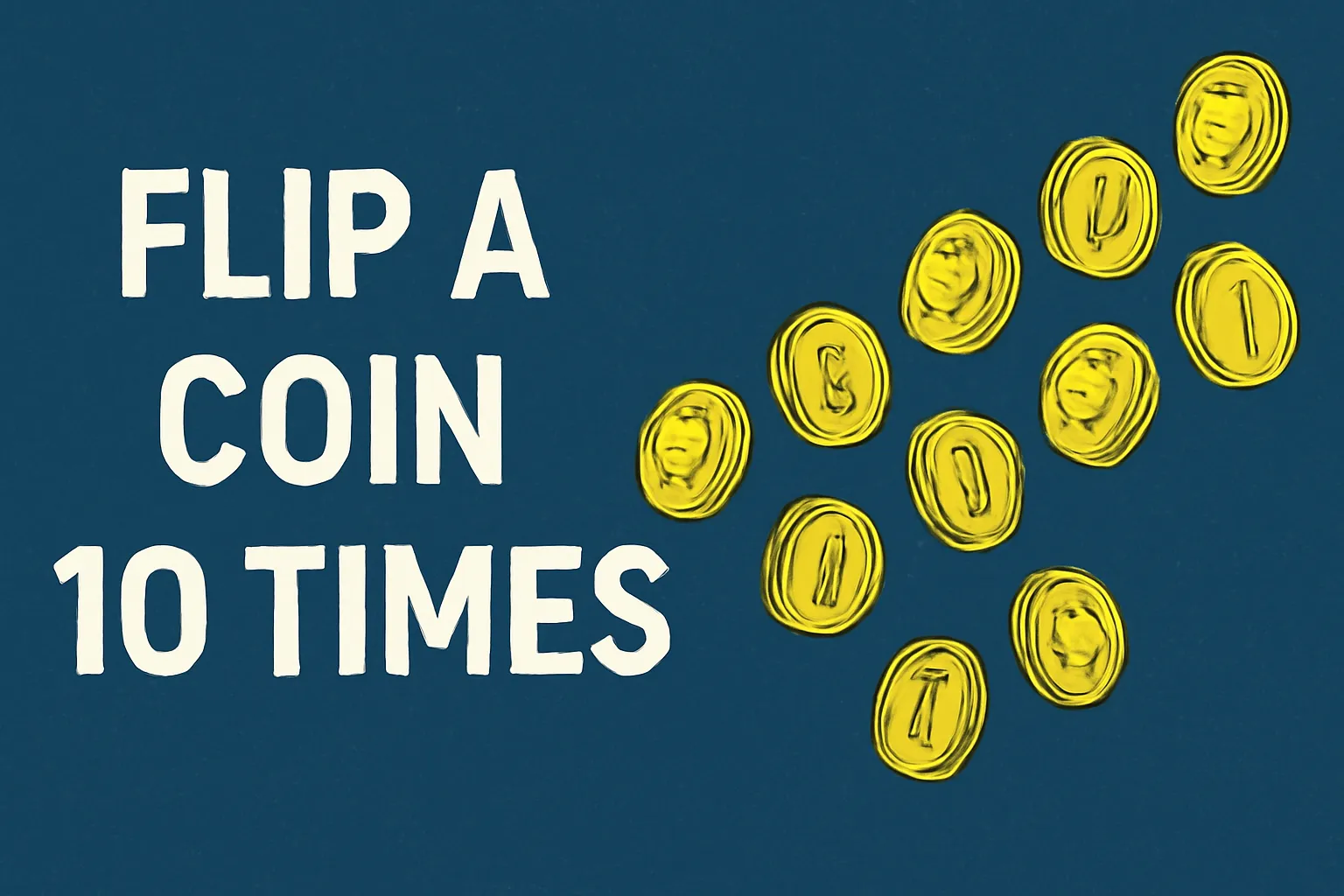Flip a Coin 10 Times: Understand the Odds & Probability
Flip a Coin 10 Times: What Are the Odds and Results?
When you flip a coin 10 times, you might receive the perfect 50/50 mix of tails and heads, but the universe is actually not that randomly nice. Learning about how much random chance is present in 10 flips of a coin is a great way to learn about randomness and statistics. We will touch on the probabilities, give a simulation tool, and talk about what you actually can expect when you flip a coin 10 times. Whether you are a student learning about probability or just curious about the randomness of a coin toss, this guide will give you everything you need to know.
Table of Contents
- How Coin Flips Work: The Basics
- The Probability of Flipping Heads or Tails 10 Times
- What Are the Likely Outcomes of Flipping a Coin 10 Times?
- Simulate Flipping a Coin 10 Times
- Conclusion: What Can We Learn From 10 Coin Flips?
How Coin Flips Work: The Basics
Coin tossing is the most basic random event, founded on the fact that there are only two possibilities: heads or tails. Every flip is independent of the others, which means that one flip does not affect the next. With a fair coin, there is always a 50% chance of landing heads or tails on any single flip. But with multiple flips of a coin, it becomes more interesting. As the number of flips is increased, the number of possible outcomes increases exponentially. For example, tossing a coin 10 times has 1,024 possible outcomes (since each toss has two options: heads or tails).
The Probability of Flipping Heads or Tails 10 Times
It might be interesting to know the probability for some outcome after tossing a coin 10 times. Here is the simple math behind it:
- The probability for flipping heads on any single toss is 0.5 (50%).
- To flip a coin 10 times, there are a total of 210 = 1,024 possible outcomes.
- The chance for 10 straight heads, for example, is extremely low—just 1 in 1,024. This indicates just how improbable that such an exact result would occur.
If you want to find the probability of getting 5 heads and 5 tails, the calculation is a bit more involved, but you can apply the formula for the binomial distribution to work it out. It will provide you with the probability of getting a specified number of heads or tails when you toss a coin 10 times.
What Are the Likely Outcomes of Flipping a Coin 10 Times?
Though the probability of getting all heads or all tails is very small, what are the possibilities of more balanced results? In life, you’re much more likely to get a mix of heads and tails. This is what you can expect to get from 10 coin flips:
- 50 heads and 50 tails: Most likely outcome, but that doesn’t necessarily mean it will occur. The more closely toward 50 heads and 50 tails, the greater the likelihood, though there are still plenty of other outcomes.
- 7 heads and 3 tails (or vice versa): Another likely outcome is one where one outcome just clears the other.
- Extremely lopsided outcomes (i.e., 10 heads or 10 tails): This is the most improbable. Although it can happen, it’s extremely unlikely—only a 1 in 1,024 chance of success.
Why does this happen is because even though each flip is random, the more you flip, the closer you get to seeing a “bell curve” or list of balanced results. So don’t worry if you don’t get exactly 5 heads and 5 tails!
Simulate Flipping a Coin 10 Times
To better visualize the randomness of flipping a coin 10 times, try out our interactive coin flip simulator. With a click of a button, you can flip a virtual coin 10 times and see the results instantly. Here’s what to expect from the tool:
- Press the button to “Flip a Coin.”
- See the results in real time (e.g., heads, tails, heads, tails).
- Keep flipping as many times as you want and monitor the spread of heads and tails.
This simulator should give you a more intuitive sense of seeing the randomness and probability of multiple coin flips, with a greater feel for hands-on understanding of how outcomes can vary.
Conclusion: What Can We Learn From 10 Coin Flips?
Flipping a coin 10 times offers an exciting window into the world of probability. While each flip has a 50/50 chance of landing heads or tails, the combined outcomes over 10 flips can vary widely. You’ll likely see a fairly even distribution of heads and tails, but extreme results like 10 heads or 10 tails are possible, albeit rare.
Through the use of software like our coin toss simulator, you can learn to develop an intuitive sense for the way that randomness really behaves in the physical world. Not only is this experiment fun, but it’s a wonderful way to learn theory about probability and statistics. Whether you’re a student with the need to study for a probability test or a person merely curious about understanding the nature of how random events occur, having ten coin tosses can really show you the way chance operates.
FAQ
Spinning a coin 10 times creates 1,024 different outcomes with the potential to be heads or tails. The result is random, but you will tend to get a fairly even outcome (such as 5 heads and 5 tails). The chance of getting all heads or all tails is highly unlikely (1 in 1,024).
The chance of getting 10 heads in a row is 1 in 1,024, or roughly 0.098%. This is a highly improbable outcome due to the randomness of every toss.
No, the result of each toss has nothing to do with the others. Therefore, it is not possible to predict the result of 10 tosses, as each of them has a 50/50 chance of resulting in heads or tails.
| Outcome | Probability |
|---|---|
| 10 Heads | 1 in 1,024 |
| 10 Tails | 1 in 1,024 |
| 50% Heads, 50% Tails | Most likely outcome |
| 7 Heads, 3 Tails | Possible outcome |




